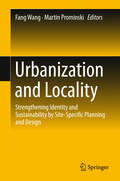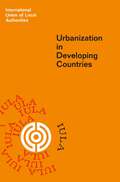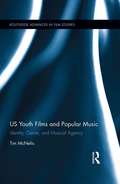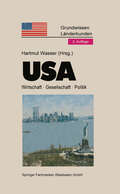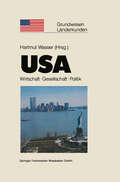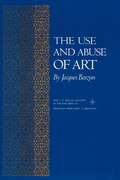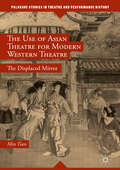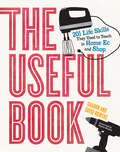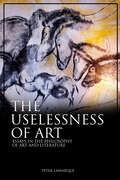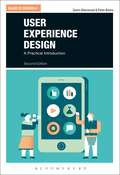- Table View
- List View
Urbanization and Locality: Strengthening Identity and Sustainability by Site-Specific Planning and Design
by Fang Wang Martin ProminskiBased on a discussion of conflicts in the urbanization process, this book provides theoretical and practical solutions for the preservation and development of urban localities. On the basis of informative case studies, it reveals the similarities and unique aspects of urbanization in Germany and China. The process of urban growth and the future trend of locality and urbanization are also examined. The book gathers contributions from architects, landscape designers, environmental engineers, urban planners and geographers, who analyze urban issues from their individual perspectives and provide methods for preserving and developing urban localities. As such, it expresses responses to urban development trends against the backdrop of sustainability in the 21st century.
Urbanization, Biodiversity and Ecosystem Services: A Global Assessment
by Thomas Elmqvist, Michail Fragkias, Julie Goodness, Burak Güneralp, Peter J. Marcotullio, Robert I. McDonald, Susan Parnell, Maria Schewenius, Marte Sendstad, Karen C. Seto and Cathy WilkinsonUrbanization is a global phenomenon and the book emphasizes that this is not just a social-technological process. It is also a social-ecological process where cities are places for nature, and where cities also are dependent on, and have impacts on, the biosphere at different scales from local to global. The book is a global assessment and delivers four main conclusions:Urban areas are expanding faster than urban populations. Half the increase in urban land across the world over the next 20 years will occur in Asia, with the most extensive change expected to take place in India and China Urban areas modify their local and regional climate through the urban heat island effect and by altering precipitation patterns, which together will have significant impacts on net primary production, ecosystem health, and biodiversityUrban expansion will heavily draw on natural resources, including water, on a global scale, and will often consume prime agricultural land, with knock-on effects on biodiversity and ecosystem services elsewhereFuture urban expansion will often occur in areas where the capacity for formal governance is restricted, which will constrain the protection of biodiversity and management of ecosystem services
Urville (PDF)
by Gilles TrehinUrville, the capital of a large island province, has a population of nearly 12 million, making it the one of the most significant cities in Europe. It is also entirely imaginary. Gilles Tréhin, an autistic man with exceptional creative talents and an obsession with large cities, conceived and developed Urville over the course of 20 years. He shares his vision in this beautifully illustrated guide to the city, which he renders convincingly real in nearly 300 drawings of different districts of Urville. He describes, in remarkable detail, the architectural styles of its individual buildings and provides historical, geographical, economic and cultural information. This includes historical figures and cultural anecdotes grounded in historical reality - Tréhin accounts for the effects of the Vichy regime, the Second World War and globalisation on his imagined city. This book offers fascinating evidence of and insight into the creative power of the autistic mind and will be of interest to people with autism and without.
US Combat Shotguns (Weapon)
by Peter Dennis Leroy Thompson Alan GillilandWhen a soldier must face multiple opponents at close quarters, few weapons can match the effectiveness of the shotgun. From World War I to the War on Terror, the shotgun has been a devastating weapon in the hands of US troops. For urban combat, prisoner control and shipboard operations, it remains as deadly today as it was a century ago. This book examines various types, from the early combat shotguns through to the riot gun and trench gun versions used in World War l. So effective was the trench shotgun, the Germans complained it violated the "Rules of War†? as an inhumane weapon, and threatened to execute troops captured carrying one. More recently during the War on Terror, shotguns have been used to clear cave complexes in Afghanistan and buildings in Iraq, but especially to blow doors open during entries and searches. Featuring specially commissioned full-color artwork, this is the story of the origins, development and the use of the combat shotgun in US service, from the trenches of World War l, to the Korean and Vietnamese Wars and lately the cave complexes of Afghanistan.
US Combat Shotguns (Weapon #29)
by Peter Dennis Leroy Thompson Alan GillilandWhen a soldier must face multiple opponents at close quarters, few weapons can match the effectiveness of the shotgun. From World War I to the War on Terror, the shotgun has been a devastating weapon in the hands of US troops. For urban combat, prisoner control and shipboard operations, it remains as deadly today as it was a century ago. This book examines various types, from the early combat shotguns through to the riot gun and trench gun versions used in World War l. So effective was the trench shotgun, the Germans complained it violated the "Rules of War†? as an inhumane weapon, and threatened to execute troops captured carrying one. More recently during the War on Terror, shotguns have been used to clear cave complexes in Afghanistan and buildings in Iraq, but especially to blow doors open during entries and searches. Featuring specially commissioned full-color artwork, this is the story of the origins, development and the use of the combat shotgun in US service, from the trenches of World War l, to the Korean and Vietnamese Wars and lately the cave complexes of Afghanistan.
The US-Mexico Border in American Cold War Film: Romance, Revolution, and Regulation (Screening Spaces)
by Stephanie FullerThrough an analysis of Cold War Era films including Border Incident , Where Danger Lives , and Touch of Evil , Stephanie Fuller illustrates how cinema across genres developed an understanding of what the U.S.-Mexico border meant within the American cultural imaginary and the ways in which it worked to produce the border.
US Youth Films and Popular Music: Identity, Genre, and Musical Agency (Routledge Advances in Film Studies)
by Tim McNelisThis book brings theory from popular music studies to an examination of identity and agency in youth films while building on, and complementing, film studies literature concerned with genre, identity, and representation. McNelis includes case studies of Hollywood and independent US youth films that have had commercial and/or critical success to illustrate how films draw on specific discourses surrounding popular music genres to convey ideas about gender, race, ethnicity, sexuality, and other aspects of identity. He develops the concept of ‘musical agency’, a term he uses to discuss the relationship between film music and character agency, also examining the music characters listen to and discuss, as well as musical performances by the characters themselves
US Youth Films and Popular Music: Identity, Genre, and Musical Agency (Routledge Advances in Film Studies)
by Tim McNelisThis book brings theory from popular music studies to an examination of identity and agency in youth films while building on, and complementing, film studies literature concerned with genre, identity, and representation. McNelis includes case studies of Hollywood and independent US youth films that have had commercial and/or critical success to illustrate how films draw on specific discourses surrounding popular music genres to convey ideas about gender, race, ethnicity, sexuality, and other aspects of identity. He develops the concept of ‘musical agency’, a term he uses to discuss the relationship between film music and character agency, also examining the music characters listen to and discuss, as well as musical performances by the characters themselves
Usability-Engineering in der Medizintechnik: Grundlagen - Methoden - Beispiele (VDI-Buch)
by Claus BackhausErgonomisch gestaltete Medizintechnik führt zu effizienteren Arbeitsabläufen, erhöht die Patientensicherheit und reduziert die Arbeitsbelastung. Das Buch erläutert, wie Medizintechnik an die Bedürfnisse der Nutzer und Anwender angepasst werden kann. Durch das beschriebene Vorgehen ist es möglich, sowohl die Anforderungen der harmonisierten Normen DIN EN 62366 und DIN EN 60601-1-6 umzusetzen als auch neue Lösungsansätze für die Entwicklung innovativer Medizintechnik zu erarbeiten. Die Umsetzung wird anhand ausgewählter Praxisbeispiele erörtert.
Usability Testing for Survey Research
by Emily Geisen Jennifer Romano BergstromUsability Testing for Survey Research provides researchers with a guide to the tools necessary to evaluate, test, and modify surveys in an iterative method during the survey pretesting process. It includes examples that apply usability to any type of survey during any stage of development, along with tactics on how to tailor usability testing to meet budget and scheduling constraints. The book's authors distill their experience to provide tips on how usability testing can be applied to paper surveys, mixed-mode surveys, interviewer-administered tools, and additional products. Readers will gain an understanding of usability and usability testing and why it is needed for survey research, along with guidance on how to design and conduct usability tests, analyze and report findings, ideas for how to tailor usability testing to meet budget and schedule constraints, and new knowledge on how to apply usability testing to other survey-related products, such as project websites and interviewer administered tools. - Explains how to design and conduct usability tests and analyze and report the findings - Includes examples on how to conduct usability testing on any type of survey, from a simple three-question survey on a mobile device, to a complex, multi-page establishment survey - Presents real-world examples from leading usability and survey professionals, including a diverse collection of case studies and considerations for using and combining other methods - Discusses the facilities, materials, and software needed for usability testing, including in-lab testing, remote testing, and eye tracking
The Use and Abuse of Art
by Jacques BarzunThe lecturer traces the historical development of attitudes toward the arts over the past 150 years, suggesting that the present is a period of cultural liquidation, nothing less than the ending of the modern age that began with the Renaissance.
The Use and Abuse of Art (The A. W. Mellon Lectures in the Fine Arts #73)
by Jacques BarzunThe lecturer traces the historical development of attitudes toward the arts over the past 150 years, suggesting that the present is a period of cultural liquidation, nothing less than the ending of the modern age that began with the Renaissance.
Use Matters: An Alternative History of Architecture
by Kenny CupersFrom participatory architecture to interaction design, the question of how design accommodates use is driving inquiry in many creative fields. Expanding utility to embrace people’s everyday experience brings new promises for the social role of design. But this is nothing new. As the essays assembled in this collection show, interest in the elusive realm of the user was an essential part of architecture and design throughout the twentieth century. Use Matters is the first to assemble this alternative history, from the bathroom to the city, from ergonomics to cybernetics, and from Algeria to East Germany. It argues that the user is not a universal but a historically constructed category of twentieth-century modernity that continues to inform architectural practice and thinking in often unacknowledged ways.
Use Matters: An Alternative History of Architecture
by Kenny CupersFrom participatory architecture to interaction design, the question of how design accommodates use is driving inquiry in many creative fields. Expanding utility to embrace people’s everyday experience brings new promises for the social role of design. But this is nothing new. As the essays assembled in this collection show, interest in the elusive realm of the user was an essential part of architecture and design throughout the twentieth century. Use Matters is the first to assemble this alternative history, from the bathroom to the city, from ergonomics to cybernetics, and from Algeria to East Germany. It argues that the user is not a universal but a historically constructed category of twentieth-century modernity that continues to inform architectural practice and thinking in often unacknowledged ways.
The Use of Arthurian Legend in Hollywood Film: From Connecticut Yankees to Fisher Kings (Contributions to the Study of Popular Culture)
by Samuel J. Umland Rebecca A. UmlandThis is the first book to examine the various uses of the Arthurian legend in Hollywood film, covering films from the 1920s to the present. The authors use five representational categories: intertextual collage (or cult film); melodrama, which focuses on the love triangle; conservative propaganda, pervasive during the Cold War; the Hollywood epic; and the postmodern quest, which commonly employs the grail portion of the legend. Arguing that filmmakers rely on the audience's rudimentary familiarity with the legend, the authors show that only certain features of the legend are activated at any particular time. This fascinating study shows us how the legend has been adapted and how through the popular medium of Hollywood films, the Arthurian legend has survived and flourished.
The Use of Asian Theatre for Modern Western Theatre: The Displaced Mirror (Palgrave Studies in Theatre and Performance History)
by Min TianThis book is a historical study of the use of Asian theatre for modern Western theatre as practiced by its founding fathers, including Aurélien Lugné-Poe, Adolphe Appia, Gordon Craig, W. B. Yeats, Jacques Copeau, Charles Dullin, Antonin Artaud, V. E. Meyerhold, Sergei Eisenstein, and Bertolt Brecht. It investigates the theories and practices of these leading figures in their transnational and cross-cultural relationship with Asian theatrical traditions and their interpretations and appropriations of the Asian traditions in their reactional struggles against the dominance of commercialism and naturalism. From the historical and aesthetic perspectives of traditional Asian theatres, it approaches this intercultural phenomenon as a (Euro)centred process of displacement of the aesthetically and culturally differentiated Asian theatrical traditions and of their historical differences and identities. Looking into the displaced and distorted mirror of Asian theatre, the founding fathers of modern Western theatre saw, in their imagination of the 'ghostly' Other, nothing but a (self-)reflection or, more precisely, a (self-)projection and emplacement, of their competing ideas and theories preconceived for the construction, and the future development, of modern Western theatre.
Use Scraps, Sew Blocks, Make 100 Quilts: 100 Stash-busting Scrap Quilts
by Stuart HillardUse Scraps, Sew Blocks, Make 100 Quilts is the new book from the Sewing Bee’s quilting supremo Stuart Hillard. Featuring 100 block patterns and 100 fabulous quilt designs, this book enables readers to sew a fantastic collection of scrap quilts.
The Useful Book: 201 Life Skills They Used to Teach in Home Ec and Shop
by David Bowers Sharon BowersA modern and energetically designed encyclopedia of DIY with everything you need to know to roll up your sleeves and cook it, build it, sew it, clean it, or repair it yourself. In other words, everything you would have learned from your shop and home ec teachers, if you'd had them.The Useful Book features 138 practical projects and how-tos, with step-by-step instructions and illustrations, relevant charts, sidebars, lists, and handy toolboxes. There&’s a kitchen crash course, including the must-haves for a well-stocked pantry; how to boil an egg (and peel it frustration-free); how to grill, steam, sauté, and roast vegetables. There&’s Sewing 101, plus how to fold a fitted sheet, tie a tie, mop a floor, make a bed, and set the table for a formal dinner. Next up: a 21st-century shop class. The tools that everyone should have, and dozens of cool projects that teach fundamental techniques. Practice measuring, cutting, and nailing by building a birdhouse. Make a bookshelf or a riveted metal picture frame. Plus: do-it-yourself plumbing; car repair basics; and home maintenance, from priming and painting to refinishing wood floors.
The Uselessness of Art: Essays in the Philosophy of Art and Literature (Critical Voices)
by Peter LamarqueOscar Wilde's famous quip 'All art is quite useless' might not be as outrageous or demonstrably false as is often supposed. No-one denies that much art begins life with practical aims in mind: religious, moral, political, propagandistic, or the aggrandising of its subjects. But those works that survive the test of time will move into contexts where for new audiences any initial instrumental values recede and the works come to be valued for their own sake. The book explores this idea and its ramifications. The glorious Palaeolithic paintings on the walls of the Chauvet Cave present a stark example. In spite of total ignorance of their original purposes, we irresistibly describe the paintings as works of art and value them as such. Here we are at the very limits of what is meant by art and aesthetic appreciation. Are we misusing these terms in such an application? The question goes to the heart of the scope and ambition of aesthetics. Must aesthetics in its pursuit of art and beauty inevitably be culture-bound? Or can it transcend cultural differences and speak meaningfully of universal values: timelessly human not merely historically relative? The case of literature or film puts further pressure on the idea of art valued for its own sake. Characters in works of literature and film or finely-honed emotions in poetry often give pleasure precisely because they resonate with our own lives and seem (in the great works) to say something profound about human existence. Is not this kind of insight why we value such works? Yet the conclusion is not quite as clear-cut as it might seem and the idea of valuing something for its own sake never quite goes away.
The Uselessness of Art: Essays in the Philosophy of Art and Literature (Critical Voices)
by Peter LamarqueOscar Wilde's famous quip 'All art is quite useless' might not be as outrageous or demonstrably false as is often supposed. No-one denies that much art begins life with practical aims in mind: religious, moral, political, propagandistic, or the aggrandising of its subjects. But those works that survive the test of time will move into contexts where for new audiences any initial instrumental values recede and the works come to be valued for their own sake. The book explores this idea and its ramifications. The glorious Palaeolithic paintings on the walls of the Chauvet Cave present a stark example. In spite of total ignorance of their original purposes, we irresistibly describe the paintings as works of art and value them as such. Here we are at the very limits of what is meant by art and aesthetic appreciation. Are we misusing these terms in such an application? The question goes to the heart of the scope and ambition of aesthetics. Must aesthetics in its pursuit of art and beauty inevitably be culture-bound? Or can it transcend cultural differences and speak meaningfully of universal values: timelessly human not merely historically relative? The case of literature or film puts further pressure on the idea of art valued for its own sake. Characters in works of literature and film or finely-honed emotions in poetry often give pleasure precisely because they resonate with our own lives and seem (in the great works) to say something profound about human existence. Is not this kind of insight why we value such works? Yet the conclusion is not quite as clear-cut as it might seem and the idea of valuing something for its own sake never quite goes away.
User Experience Design: A Practical Introduction (Basics Design)
by Gavin Allanwood Peter BeareApplicable to a wide spectrum of design activity, this book offers an ideal first step, clearly explaining fundamental concepts and methods to apply when designing for the user experience.Covering essential topics from user research and experience design to aesthetics, standards and prototyping, User Experience Design explains why user-centered methods are now essential to ensuring the success of a wide range of design projects.This second edition includes important new topics including; digital service standards, onboarding and scenario mapping. There are now 12 hands-on activities designed to help you start exploring basic UX tasks such as visualising the user journey and recognising user interface patterns.Filled with straightforward explanations and examples from around the world, this book is an essential primer for students and non-designers needing an introduction to contemporary UX thinking and common approaches. Designed specifically for newcomers to UX Design, the companion website offers extra material for hands-on activities, templates, industry interviews, contributor notes and sources of guidance for those seeking to start a career in the industry.
User Experience Design: A Practical Introduction (Basics Design)
by Gavin Allanwood Peter BeareApplicable to a wide spectrum of design activity, this book offers an ideal first step, clearly explaining fundamental concepts and methods to apply when designing for the user experience.Covering essential topics from user research and experience design to aesthetics, standards and prototyping, User Experience Design explains why user-centered methods are now essential to ensuring the success of a wide range of design projects.This second edition includes important new topics including; digital service standards, onboarding and scenario mapping. There are now 12 hands-on activities designed to help you start exploring basic UX tasks such as visualising the user journey and recognising user interface patterns.Filled with straightforward explanations and examples from around the world, this book is an essential primer for students and non-designers needing an introduction to contemporary UX thinking and common approaches. Designed specifically for newcomers to UX Design, the companion website offers extra material for hands-on activities, templates, industry interviews, contributor notes and sources of guidance for those seeking to start a career in the industry.
